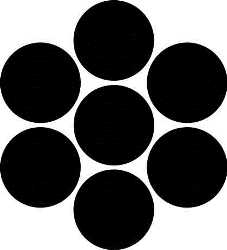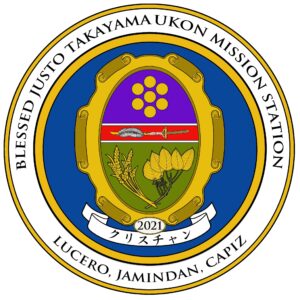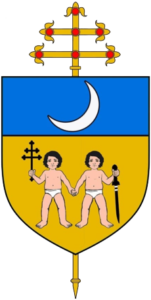The Blessed Justo Takayama Ukon Mission Station
Our Patron

Blessed Justo Takayama Ukon of Manila
Blessed Justo Takayama Ukon was born in 1552, the same year that the famed missionary Jesuit Saint Francis Xavier died. He was baptized at age 12 after his father, Darius, had received the sacrament of baptism. Blessed Justo was a samurai (Japanese warrior) of renown. He was a peerless general on the field and a castellan known for fortifying some of the most important castles of the time (some still stand today). He was much more than a powerful warrior though; he was a cultural and religious leader. He helped perfect the Japanese art of tea ceremony and engaged in crafting implements for the ritual. Most importantly he was a church builder. He used his craftsmen to build the physical churches and his exemplary character and devotion to Christ to fill those churches with Christian converts.
Blessed Justo’s faith was challenged three times. Each time he was faced with moral dilemma, and he was exiled to far parts of Japan and eventually to the Philippines where he died a martyr. He could have apostatized but each time he refused, no matter how harsh the punishment was.
First Trial
Blessed Justo’s first moral dilemma was one of loyalty to his family (his son and sister), or to that of the Christian community. One faction held his family as political hostages and the other threaten to murder the thousands of Christians who lived under his protection. Being stuck in an impossible situation he resigned his military commission taking away the leverage both parties had over him. His courage to protect all of them was highly regarded. He cared little for titles and prestige, his only concern were for the Christians in his charge and his family.
Second Trial
The second time Blessed Justo incurred the ire of the most powerful warlord in Japan. The warlord made Christianity illegal and demanded Blessed Justo renounce his faith or face exile in the hinterland provinces of Japan. He refused to apostatize and took his family into exile with him, to the islands of the Seto Inland Sea.
Blessed Justo was eventually allowed to return from exile, but only as a prisoner in the service of another warlord. This warlord knew of Blessed Justo’s great military genius and employed him as a guest general. Blessed Justo served with distinction. He was allowed to set up two small Christian communities for Catholic samurai who refused to give up the Faith. He planned to live out his days with these communities, but it wasn’t meant to be.
Third Trial
The supreme military general, the Shogun, was facing his last great threat from disaffected rivals. At this time the Faith was outlawed and it was a criminal offense to be Catholic. Catholics were ordered to renounce their faith. The Shogun feared that Blessed Justo would join the rival army which had many Catholic samurai. Decades before, after a battle, the man who would become Shogun said of Blessed Justo, “In the hands of Takayama Ukon 1,000 men are worth 10,000!” Early in 1614, the Shogun ordered Blessed Justo, his family, his Christian retainers, and the local priests into exile. The party had to walk through the region of Japan known as the Japanese Alps with little more than light jackets during the coldest winter months. The party had to make frequent stops to await new orders and they were fearful they might be executed at any moment, by government soldiers. If he and his family apostatized all of the harsh treatment would have stopped, but they held true to their Christian Faith.
After several months they arrived at their port on November 8th, 1614. Along with 300 other Japanese Christians the ship set sail for Manila. The journey was fraught with disaster and several people, including four priests, died. They did not arrive in Manila until December 11th, 1514. They were greeted by the Filipino locals and Spanish government as heroes. The governor of Manila offered Blessed Justo an income, but Blessed Justo refused, stating he was no longer fit for service.
Martyrdom
The long trip through Japan in harsh weather conditions, the disastrous trip across the sea, and the tropical diseases finally took their toll on Blessed Justo. On his deathbed he expressed the joy he felt to be able to die in the Philippines, a Christian country. He said to his confessor, “I desire now to go to enjoy my Lord and Savior.” Blessed Justo died just after midnight on February 3rd, 1615. He was given a state funeral and laid to rest at St. Ana’s Church in Intramuros.
Beatification
In 1630, the Manila Archdiocese of the Catholic Church petitioned the Sacred Congregation for Rites in Rome for the first time, to open a case to canonize Blessed Justo. Because Japan had self-isolated the investigation could not commence until the 20th century. Through the work of the priest Father Hubert Cieslik, and the researcher Dr. Ernesto De Pedro the positio reached the Vatican. It was determined that Blessed Justo had died a martyr for Hatred of the Faith. On February 7th, 2017, the Holy Father, Pope Francis beatified Blessed Justo Takayama Ukon of Manila. His feast day is February 3rd. Blessed Justo is the patron of persecuted Christians, Japanese immigrants, and the University of Santo Tomas Graduate School.
Blessed Justo Takayama Ukon is a powerful intercessor. His life is an example of Christian devotion to Jesus Christ and the Blessed Mother Mary. He built churches and saved souls. Please consider helping us to build a church that will honor Blessed Justo Takayama Ukon of Manila.
At present, our pastor Rev. Fr. Krys Joseph Señerez is collecting and administering all PayPal donations.
For more information about Blessed Justo Takayama Ukon please check out https://takayamaukon.com/
Blessed Justo Takayama Ukon, pray for us!


“Go up into the hill country;
bring timber, and build the house
that I may be pleased with it,
and that I may be glorified, says the LORD.”
(Haggai 1:8)

© The Blessed Justo Takayama Ukon Mission Station, 2022-2023
Follow us on:



